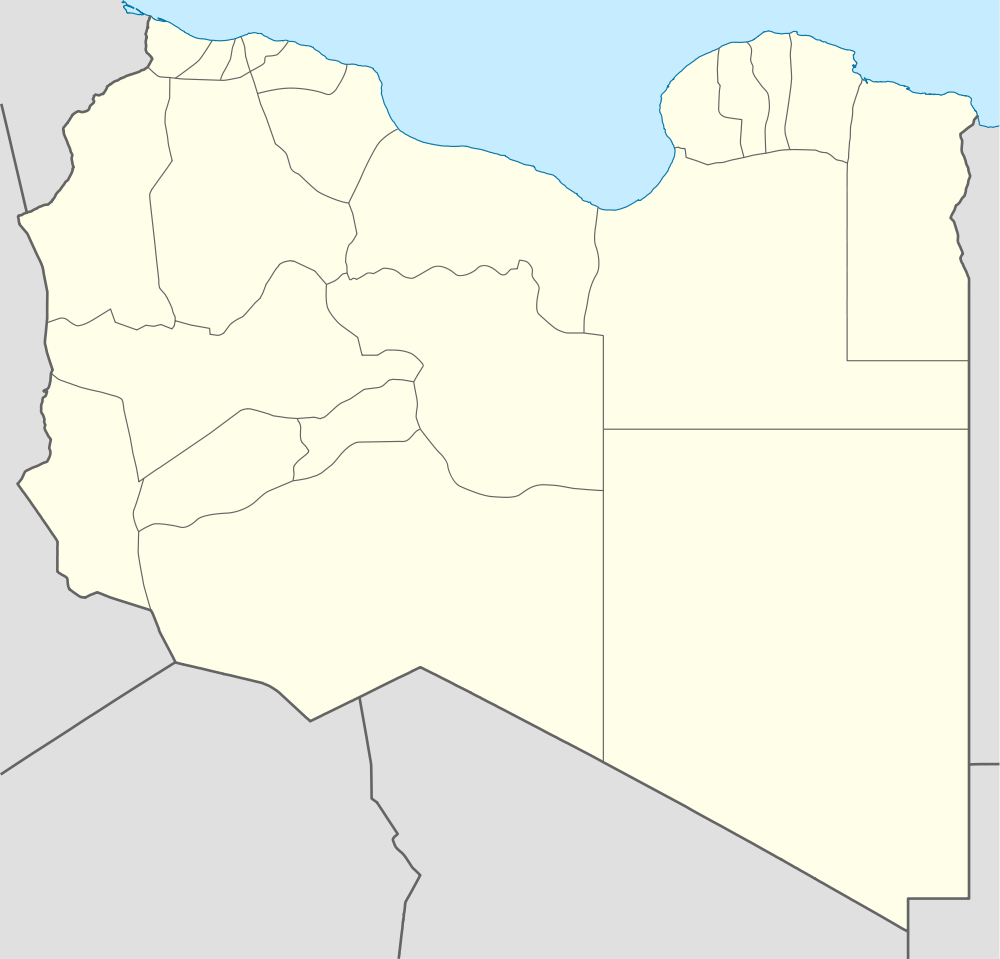Hun, Libya
| Hun هون | |
|---|---|
| Town | |
|
A view from modern Hun, Libya | |
 Hun Location in Libya | |
| Coordinates: 29°07′16″N 15°56′25″E / 29.12111°N 15.94028°E | |
| Country |
|
| Region | Fezzan |
| District | Jufra |
| Elevation[1] | 850 ft (259 m) |
| Population (2010)[2] | |
| • Total | 30,715 |
| Time zone | UTC+2 |
Hun or Houn /ˈhuːn/ (Arabic: هون Hūn) is an oasis town in the northern Fezzan region of southwest Libya. The town is the capital of the Jufra District.
Geography
Hun is about halfway between Sabha and the Mediterranean coast in the Sahara Desert. The modern city of Hun is 150 years old.
The natural landscape around Hun mainly consists of black basalt mountains, with extensive sand dunes, and date palm trees - Phoenix dactylifera groves indicating oases.
The cities of Waddan and Sokna are the nearest settlements. There is a ruined ksar and several mosques in the city of Waddan. All three towns are oases characterized by the abundance of natural springs and date palm trees.
Transportation
There are public buses to the cities of Sirte and Sabha. There is also a military airport located between Hun and Waddan, Al Jufra Air Base. Hun is 240 km south of Sirte, 370 km from Misrata and 272 km north of Sabha.[1]
Climate
Hun has a hot desert climate (Köppen climate classification BWh) with long, extremely hot summers and short, warm winters as well as very little rainfall throughout the year. In this part of the desert, summer daytime temperatures are a bit moderated due to the influence of the cooler offshore winds from the Mediterranean Sea, although averages high temperatures consistently exceed 40 °C (104 °F) during the hottest months of the year. Hun is said to bake in bright sunshine during 85 % of the daylight hours. Hun is located in one of the sunniest and driest regions in the world.
History

Hun has a history of several different settlements, each being built to replace an earlier village swallowed up by the desert, which explains why it is called "El-Huwailah" the migrating town. Although we have no information on the exact period when Izkan or Miskan (also known as the “first Hun”) was founded, we do know that the settlement disappeared five centuries ago, perhaps after an earthquake, a flood or a plague, but definitely as the consequence of a sudden and unexpected scourge.
The “second Hun” was built under Turkish rule and flourished for three and a half centuries, when it was eventually abandoned due to the sand storms that inexorably eroded the walls of the buildings. In the mid-19th century the inhabitants submitted a request to the Ottoman rulers, asking for permission to build a new town. This was to be the “third Hun”, a quadrangular, typically Arab structure that replaced the structure of the earlier Berber-style concentric settlements (like Waddan, Sokna and Zella).

In the 1970s the “third Hun” was itself abandoned, and left to fall into ruins, as the inhabitants opted for dwellings with more modern comforts (such as bathrooms inside the buildings). Today the “old town” still provides a highly evocative backdrop for exhibitions of local craftsmanship. The area where the “second Hun” stood is today a favourite place for picnics in the dunes, offering as it does a splendid view of the Marabout (a shrine and place of worship that has developed around the tomb of a holy man) and spectacular sunsets.
During the Libyan Civil War, on 8 May 2011, NATO hit 8 headquarters compound buildings, 12 ammunition storage and 20 vehicle storage.[3]
Italian Libya

During the colonial Italian Libya period, Hun was the administrative capital of the Italian Fezzan region, called Territorio del Sahara Libico. Hun was the Italian military center of southern Italian Libya, and was not part of the national Fourth Shore territory of the Kingdom of Italy as Italian Tripolitania and Italian Cyrenaica were.
A small Libyan Italian community of 1,156 people lived in Hun, which was called Homs in the colonial years. In the 1939 census they were 3% of the total population of 35,316 in the city. They disappeared from Hun after Italy's loss of Libya in World War II. An important Libyan Italian born in Hun was the internationally renowned painter Mario Schifano (1934–1998).
In the 1930s the Italian government made some important improvements to the small town, including a connection to the coast via the new Fezzan Road.
Features
The "International Autumn Tourism Festival", is an annual festival usually held at the end of September.
- Accommodations
There is one hotel and one hostel in Hun.
Notes
- ↑ 1.0 1.1 Wolfram Alpha
- ↑ estimated ""Libya: largest cities and towns and statistics of their population"". Archived from the original on 8 Dec 2012. World Gazetteer
- ↑ http://www.nato.int/nato_static/assets/pdf/pdf_2011_05/20110508_110508-oup-update.pdf
See also
External links
Coordinates: 29°07′16″N 15°56′25″E / 29.12111°N 15.94028°E
| ||||||||||||
| ||||||
